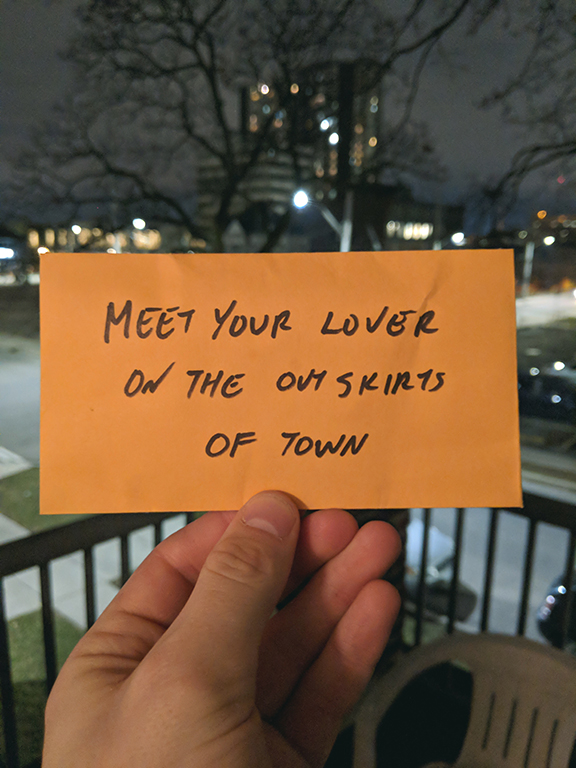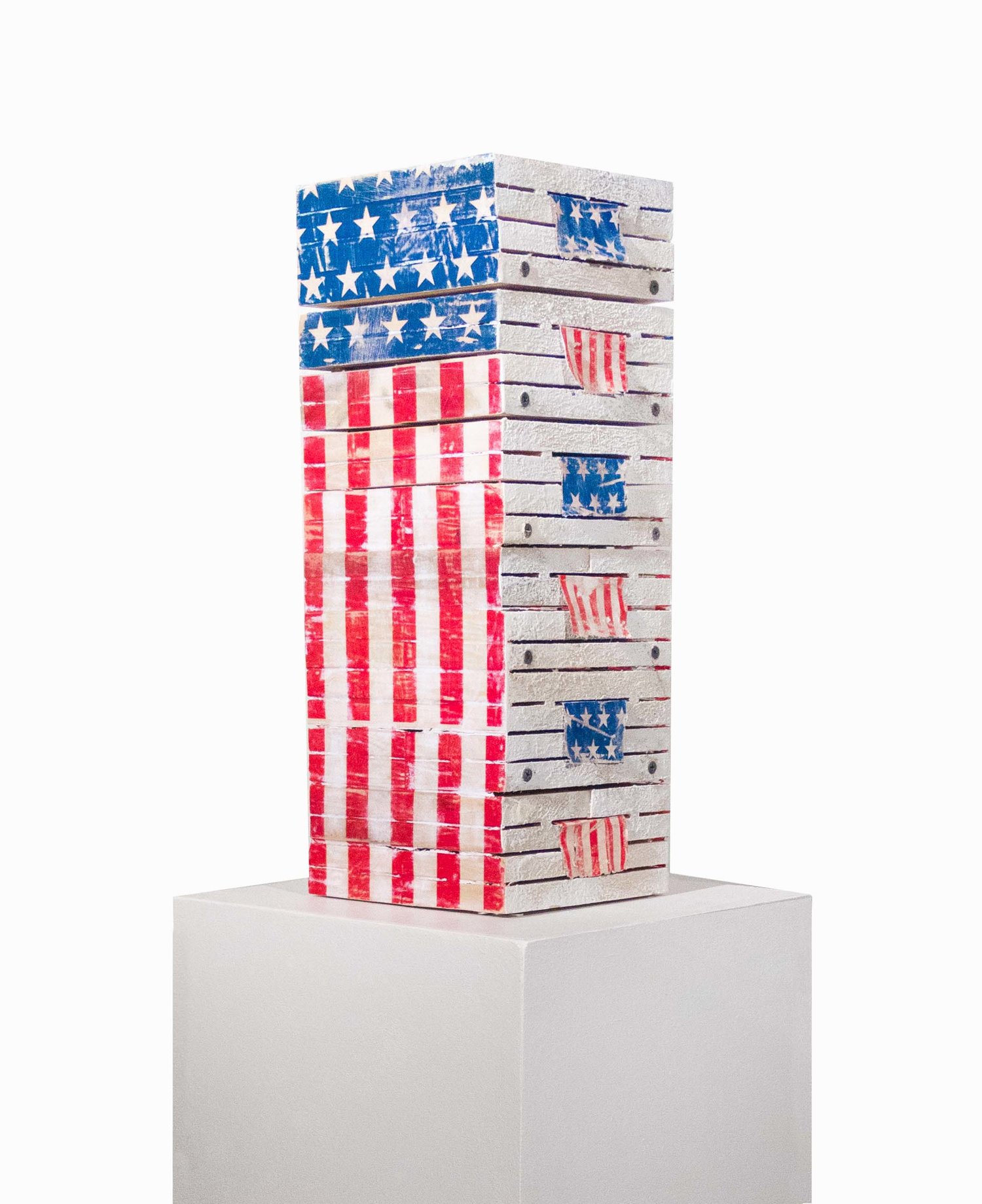Suburbia Is Calling
Spring 2018, cover image by Eric Magassa, artist featured.Barbed's latest issue titled Suburbia Is Calling is finally here! Artists were invited to participate on a call for submission surrounding the theme suburbia. The artists featured on this issue are:
Alicia Degener
Dave D'amico
Luke Maddaford
Salvador Campos
Verna-Valencia
William Ten Eick
AJ Cooke
Alana Bartol
Ian Gallywag
Jesse Ng
Andrew Mehall
Gregory Hatch
Melanie Manos
Sasha Opeiko
Eric Magassa, and
Troy Hoffman
The 6th issue of Barbed is partially sponsored by: Grinstein Jewelry & Design
Preview


Page 39. Notes for a Queer Manifesto (2018) is the work by Canadian artist Luke Maddaford, based in Windsor, Ontario.
Luke Maddaford is an interdisciplinary Canadian artist currently living and working in Windsor, ON. His practice explores the intersection of identity and place, looking at how spaces and places influence the ways we identify. He holds special interest in queer identity, rurality, and the temporality of space.
Notes for a Queer Manifesto is an ongoing collection of text, images, and objects. It is a personal archive reflecting my interactions within the queer community. The collection is meant to offer a glimpse into queer culture, challenge common narratives within the community, and attempt to offer a guide for potential futures. It is perpetually incomplete and acts as both a research practice and record of existence.


Page 19. HOW DID YOU GOT HERE? (HIDDEN VALLEYS) By Andrew Mehall
"Does the distance between Salt Lake City and New Orleans and their shared history of the 'Jazz' franchise fracture New Orleans’ claim on the genre of music itself? Jazz being outlawed in 'New' Orleans with the 'Old' Orleanians, the Atakapa (including the Opelousas), the Caddo (including the Natchitoches), the Chitimacha, the Choctaw, the Houma, the Natchez (including the Taensa and Avoyel), and the Tunica being outlawed in name and body. Jazz as a bridging, reformation (in the Voltron sense), of diasporic mid-triangle trade supply chain playing different drum languages, intertwined, magpied, in Congo Square, Sundays only. Sundays in Congo Square being one of the least most conceptions one can imagine Joseph Smith inventing.
"Does the distance between Salt Lake City and New Orleans and their shared history of the 'Jazz' franchise fracture New Orleans’ claim on the genre of music itself? Jazz being outlawed in 'New' Orleans with the 'Old' Orleanians, the Atakapa (including the Opelousas), the Caddo (including the Natchitoches), the Chitimacha, the Choctaw, the Houma, the Natchez (including the Taensa and Avoyel), and the Tunica being outlawed in name and body. Jazz as a bridging, reformation (in the Voltron sense), of diasporic mid-triangle trade supply chain playing different drum languages, intertwined, magpied, in Congo Square, Sundays only. Sundays in Congo Square being one of the least most conceptions one can imagine Joseph Smith inventing.
Jazz and Cowboys shaped America, even if it was smallpox that killed the Indians. Or maybe it was just typical colonial interaction, wherein extinction usually occurs within fifty years. By using Indian rather than Native Amer-ican offers the romantic Cowboy/Indian binary, destiny manifested (Mannie Fresh’d it, New Orleans), producing what may be the biggest, dumbest use of naming in all time. Of course, understandably many American Indian folks prefer this term, in large part, it’s a term that reveals how misunderstood and marginalized they are and have been. Native American isn’t a neutral term. Naming isn’t an exercise in neutrality. History can be reductive and has been apocryphal, so consider white people—European contact—coming to ‘America,’ realizing it’s not India, staying anyway, just because, decimating an entire people, and then sticking the few left, the survivors, with the lazy, ill-conceived name they gave them, Indians. Herbie Stempel put it more eloquently: ‘You know why they call them Indians? Because Columbus thought he was in India. They’re ‘Indians’ because some white guy got lost.’ ”
Page 73. When I Touch Terrycloth By Gregory Hatch
I'm letting my eyes wander trying to find the locker I had picked out just an hour earlier. I am keenly aware of how many other guys are around me and what level of attention they give to my entrance to the locker room. I am starting to feel any relaxation I had gained from the elliptical slip away as the familiar sense of panic and insecurity wash over me. My eyes find my cheap tin padlock, and I feel myself propelled forward by habit and intention. My medal is a cold contrast to my overheating body as I fumble to find the tiny aluminum key to help to end this self-induced ritual of self-awareness. The lock gives and I bristle as a barrel-chested barrel of muscle and masculinity moves inches away from me, easily undoing his lock and retrieving his hoodie. My hands reach up and pull down the hastily stored items from the top of the locker and place them on the narrow bench behind me. My mind automatically name off the items (shampoo, keys, underwear, towel) before I let my nervous dance proceed. My shoes come off easily, my sweat plastered socks not so much. I reach down and pry the last section off my foot and stuff them into my gym bag. Cheeks begin to simmer red remembering embarrassments born from high school gym periods and improperly buried within my own psyche. I lift my shirt and thrust it quickly into the bag with the socks. I didn't want to give myself any option to drive home chilled by cold drying sweat and hungry for my own bathroom, my own shower. I make a quick turn and pick up the cornflower towel and roughly tying it around my overly high waist. My hands reach under the towel and pull down and off my briefs and shorts like an awkward magic trick that I am not even impressed by. I know my crack has flashed any roaming eye behind me and I feel an out of place thrill that gets drowned out by my feelings of inadequacy. I stand straight and finish re-buckling my dollar's worth of security before heading to the showers. The terrycloth kicks out with my knee with every step acting like a reserve fig leaf, advertising the shame I felt rather than hiding it. I stand before the shower stall curtain and arrange my items in an order that makes perfect sense to me. The water is turned on, its slow methodical heating process pushing the levels of my anxiety. The hurried tucked knot of the towel seems like a weak joke as I test the tepid water for the 5th time in those short moments. My need to be hidden wins out against my tolerance for cold showers, and I unceremoniously pull off the terrycloth fabric and plunge forward into the tiled cubicle, slamming the curtain shut behind me. As much as anyone can slam a fabric shower curtain.


Page 49. Works by William Ten Eick
“I am interested in exploring subjects of the American landscape, society, and condition within my photography. Something about the combination of colors of red, white, and blue has ingrained an importance within my subconscious. My parents recently showed a video clip of me as a toddler running around in my blue overalls, waiving an American flag. In the video my mother is seen handing me the flag and preceding to laugh as I bump into the kitchen cabinets, falling down onto our linoleum floor. Even as I fell, I continued to grasp the flag I was holding. It was watching this video that I realized just where the origins of my obsessions into the Americana began. I find myself often escaping out to the Chicago suburbs to photograph. Something about these environments brings me comfort and nostalgia, reminding me of the past. The stagnation, predictability, and mindless conformity of the suburbs also acts as a brief mental escape from my current life in Chicago. I subvert my feelings into subjects I photograph as a form of psychological therapy. My images could be read as a critique on broken aspects of American society or a self portrait, in which I appropriate forms within my photos as physical emotional representations of myself. It is this middle ground that I feel my work can be the most accessible to viewers, without cancelling out myself. I feel if my work can cause you to question larger subjects in regards to the American condition, as well as still feel connected on a personal level; I have succeeded in portraying what is most important to myself, as well as my art. “
Images:
Untitled, Archival Pigment Print, 45” x 65”. 2017. Stacked, wood, metal, wax, paper, acrylic paint,
10” x 10” x 40”. 2016
Page 55. Alana Bartol , A Woman Walking (the City Limits), 2016, Performance, Calgary, Alberta
14 photographs (11 x 34 in), 30 min video, Risograph
(11 x 17in) photographs printed on Moab Somerset Museum Rag.
What bodies move alongside, within, and outside of the designated city boundaries? How is the border of Calgary inscribed on the land and felt in space? How might we see walking as both practice and knowledge?In the summer of 2016, I attempted to walk along the city limits of Calgary (174 km+), tracing the walk through collected objects, photographs, drawing, and video. My work often sees me mov-ing through and within liminal spaces where urban space meets suburban sprawl. Without sanctioned pathways or access points, we rarely experience these spaces on foot and instead see them from a distance or not at all. In this work, the City of Calgary map becomes a virtual guide. While the City limit runs alongside roads and highways, it also demarcates the border along Tsuut’ina Nation 145, dips and crosses both The Bow and Elbow rivers, runs directly along the Bearspaw Dam, moves across private property, farmlands, and sinks into ponds.



A Woman Walking (the City Limits), Township Road 261A, Bearspaw Dam, and Symons Valley Rd NW. 2016 Performance, Calgary, Alberta, CAN.